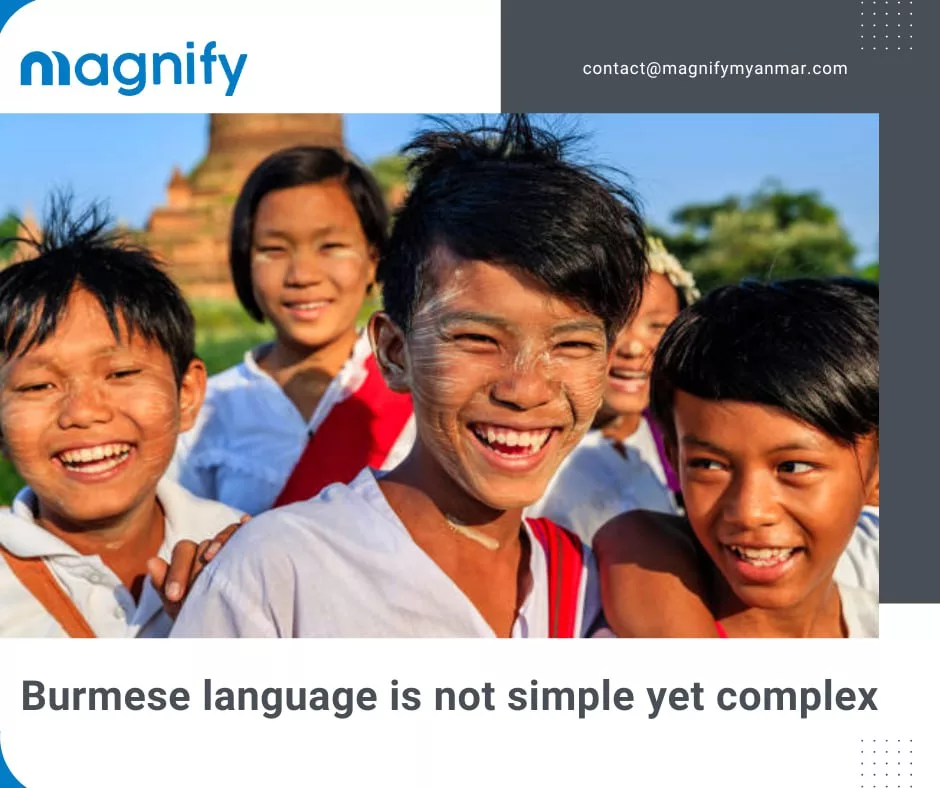Category: Language
မြန်မာစကားလုံးတွေဟာ အရမ်းကို ရှုပ်ထွေးပါတယ်။

မြန်မာစကားလုံးတွေဟာ အရမ်းကို ရှုပ်ထွေးပါတယ်။ ဘာသာစကားတွေထဲမှာ အဓိပ္ပာယ်အများဆုံးနဲ့ နားလည်ရအခက်ဆုံးဘာသာကိုညွှန်ပြပေးပါဆိုလျှင် မြန်မာဘာသာကိုသာ ဦးစွာပြေးမြင်ရပါလိမ့်မယ်။
မြန်မာစကားလုံးတွေဟာ ပါဠိပါဌ်ဆင့်တွေကနေ ဆင်းသက်လာခဲ့ပြီးတော့ ခေတ်ကာလပြောင်းလဲလာတာနဲ့အမျှ စကားလုံးအဓိပ္ပာယ်တွေဟာ လက်ရှိခေတ်ကာလသဘောအရရော ရှေးယခင်ကယူဆတွေးတောချက်တွေကိုပါ မြန်မာလူမျိူးတွေဟာ ယှဉ်တွဲအသုံးပြုကြတာကို တွေ့ရှိလာရပါတယ်။
အဂ်လိပ်စကားလုံးတစ်လုံးရဲ့အဓိပ္ပာယ်နဲ့ မြန်မာစကားလုံးတစ်လုံးရဲ့ အဓိပ္ပာယ်ကို လေ့လာကြည့်မယ်ဆိုလျှင် မြန်မာစကားလုံးဟာ တစ်လုံးတည်းနဲ့အဓိပ္ပာယ်ကို မဖြေရှင်းနိုင်ပဲ စကားလုံးတစ်လုံးစီတိုင်းနဲ့ ချိတ်ဆက်ပြီးမှသာ အနက်အဓိပ္ပာယ်ဟာ ပြည့်စုံလာပါတယ်။
မြန်မာစကားလုံးတွေဟာ ပေါ့ပေါးပါးပါးလေးလို့လည်း ထင်ရပေမယ့် စာကြောင်းလေးတွေကို စုစည်းလိုက်မယ်ဆိုလျှင် အဓိပ္ပာယ်လေးနက်လာပြီး မည်သည့်အပြုသဘောဆောင်ပြီး မည်သို့ပြောဆိုနေကြသလဲ ဆိုပြီး စဉ်းစားစရာတွေ ရရှိလာပါတယ်။
လက်ရှိမြန်မာနိုင်ငံမှာ Public နဲ့ ချိိတ်ဆက်နေရသောလုပ်ငန်းကြီးတွေဟာ သုံးစွဲသူတွေရဲ့ စကားသံကို နားထောင်ရပါတယ်။သုံးစွဲသူတွေရဲ့အသံကိုနားထောင်ပြီဆိုလျှင် သူတို့ပြောတဲ့ဒေတာတစ်ခုစီတိုင်းကို သေချာခွဲခြမ်းလေ့လာဖို့ကလည်းအရေးကြီးပါတယ်။
ဥပမာအားဖြင့်
၁။ “ဒီပစ္စည်းလေးက လှလိုက်တာနော်။ကြိုက်ပေမယ့် စျေးကြီးတယ် လိုလဲလိုချင်လိုက်တာ”
၂။ “စျေးကြီးပေမယ့်လည်း သုံးရတာပျော်တယ်”
၃။ “အမလေးနော် အရမ်းကောင်းရှာတာကိုး”
ဒီစကားစုတွေကိုကြည့်ပြီး သုံးစွဲသူဒေတာအနေနဲ့ခွဲခြားရမယ်ဆိုလျှင် Positive လား Negative လား Interest လား စသဖြင့် စဉ်းစားစရာ ရလာပါလိမ့်မယ်။
ပထမစာကြောင်းရဲ့ “ဒီပစ္စည်းလေးကလှလိုက်တာ “ဆိုတာကို စတင်စဉ်းစားမယ်ဆိုလျှင် ကောင်းတာပြောလို့အကောင်း” Positive “လား? စျေးကြီးတာဆိုတာလည်းပါတော့ အဆိုး “Negative” လား?
စျေးကြီးပေမယ့်လည်းကောင်းလို့ ပျော်တယ်ဆိုတာကရေဘာလဲ? ကောင်းတာရော ဆိုးတာရောတွဲထားပြီး စကားလုံးအလေးသာတာက အကောင်းလား?
မြန်မာစကားလုံး “ကောင်းတယ်” ဆိုတာက အကောင်းပြောတော့ Positive လို့ထင်ရပေမယ့် နောက်ဆုံးစာသားကိုကြည့်မယ်ဆိုလျှင် “အမလေးနော် ကောင်းရှာတာကိုး” ဆိုတဲ့စကားစုမှာ “ကောင်းရှာတာကိုး” ဆိုတဲ့စကားကိုကြည့်ရင် “ကောင်း” ဆိုတဲ့စကားတစ်ခုတည်းဆိုရင် ကောင်းတယ် ပေါ့။ “ရှာ” တစ်လုံးထဲဆိုလျှင် “ပစ္စည်းပျောက်လို့ရှာတာလား”စသဖြင့် အဓိပ္ပာယ်ဟာ ပြောင်းလဲသွားပြီးတော့ ကောင်းနဲ့ ပေ့ါင်းလိုက်တဲ့အခါ ရွဲ့စောင်းပြီးပြောသလို အဓိပ္ပါယ် သက်ရောက်သွားပါတယ်။ တော်ရုံtool တွေဟာ ကောင်းတာကိုပဲသတ်မှတ်ပြီး Positive အနေနဲ့ ခွဲခြားလိုက်မယ်ဆိုလျှင် ဒေတာဟာ ယူဆပုံဟာ မှားပါတယ်။ ဒါကြောင့် မြန်မာဘာသာစကားရဲ့ အဓိပ္ပာယ်ဟာ ရိုးရှင်းပေမယ့် လေးနက်တယ်လို့ ခေါ်စမှတ်သွင်တာပါ။
Magnify Myanmar ရဲ့ Social Listening Tool ဟာ မြန်မာဘာသာစကားတစ်ခုချင်းစီတိုင်းရဲ့အဓိပ္ပာယ်ကိုနားလည်တာကြောင့် ဒေတာခွဲခြားရာမှာ အထောက်အကူများစွာပြုပါတယ်။ စကားလုံးများရဲ့အဓိပ္ပာယ်ကြောင့် အချိန်မကုန်စေပဲ ဒေတာတွေကိုရှင်းလင်းပြတ်သားစွာခွဲခြားနိုင်ပြီး သုံးစွဲသူများရဲ့အသံကို သေချာနားထောင်နိုင်စေဖို့ရန် Social Listening Tool အကြောင်းကို သိရှိလိုပါက Magnify Myanmar ရဲ့ ဖုန်းနံပါတ် 09-791029719 သို့မဟုတ် ဖော်ပြပါ Link မှတစ်ဆင့် Free Trial အတွက် အသေးစိတ်တိုင်ပင်ဆွေးနွေးနိုင်ပါတယ်။
Burmese language is complicated even for native speakers. It could even be considered as one of the most complex languages. The language is derived from the Pali language, and as time changes, it has been found that people in Myanmar these days use a mixture of the meanings from the old time and the new terms.
If we look at the meaning of an English and a Burmese word, it is seen that the meaning of a Burmese word cannot be explained in one word but makes more sense when the words are linked to each other.
Burmese words can be seen as light-hearted, but when you put the sentences together, the meaning becomes more profound, which leads you to think about which tone they are using. It is essential for businesses these days to pay attention to consumer feedback as well as to analyze them. For instance,
- “This item is beautiful. I like it, but it was expensive. I want it”
- “Expensive but fun to use.”
- Oh my god, it not much found good”
Looking at the phrases above, it is pretty complicated to determine if they’re positive/negative feedback or an inquiry.
If we look at the phrase “This item is beautiful “in the first sentence, it can be viewed from many angles. It could be “positive” feedback because it mentioned that it’s pretty, or it could be “negative” because it mentioned the product’s high price. Or we can view it as a sentence with the combination of a positive and negative tone, then determine the sentiment according to the weight of that tone.
Although the word “good” alone sounds positive, if we look at the phrase “not much found” in the second sentence, the tone becomes the complete opposite. “good” means good and “not much found” means search, but when you combine the two words, it becomes a sarcasm. Most AI tools usually would take this sentence as a positive sentiment when it’s a negative one. This is why we say that the Burmese language is simple yet confusing.
Magnify Myanmar’s social listening tool is run by a well-trained AI system to understand the complex structures of the Burmese language. With our tool, you can analyze the words in precise tone and save time trying to understand what consumers are saying. To learn the details, contact 09-791029719 or click the link below for a free trial.


